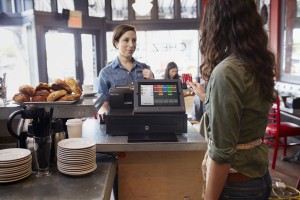 In the highly competitive retail space, businesses must do all they can to improve the shopping experience. Consumers have plenty of choices, and making a purchase can be as easy as a few taps on a smartphone or tablet screen.
In the highly competitive retail space, businesses must do all they can to improve the shopping experience. Consumers have plenty of choices, and making a purchase can be as easy as a few taps on a smartphone or tablet screen.
Shoppers have grown accustomed to that level of convenience are less and less inclined to queue up in front of a cash drawer to buy something at a brick-and-mortar store. With Thin-bility, they don’t have to. “Thin-bility” is the term APG has coined to refer to an emerging POS model that combines thin client, mobile, and cloud-based technologies to replicate the convenience and ease of shopping online.
Thin-bility benefits both shoppers and merchants. Bluetooth and IP-enabled POS components such as cash drawers, printers, and barcode readers can communicate wirelessly with tablets that serve as mobile checkouts. This means store clerks literally can take the checkout to the shopper at the point of decision to complete transactions.
The appeal to merchants is that Thin solutions are less expensive than traditional PC-based POS systems. A typical “fat client” POS workstation costs around $3,000, bringing a five-unit rollout to $15,000, expensive for a small retailer. A deployment of five $400 tablets costs $2,000, and the units are easier to use and cheaper to replace. Cash drawers and printers have their own price tags, but they can be shared because they are IP-enabled, so fewer are needed. Depending upon the peripheral configuration, tablet solutions can cost the retailer between $3,000 and $4,000. This brings the total cost of a Thin-bility system to about the same as one traditional POS station.
For POS dealers and VARs, there is an excellent opportunity to make a compelling case to their customers to migrate to Thin-bility systems. You can lower their costs while helping them bring convenience to their own customers.
There is also a service component. Thin-bility goes beyond the traditional break fix aspect of service. Integrating Thin POS continues to use recently acquired PCI networking skills and expands them for secure in-store date exchange.
 There are also additional benefits to the retailer as well. APG’s IP-enabled cash drawers have built-in intelligence allowing them to capture and store transaction data that helps identify security issues and determine if cashiers are properly trained. Programmable features enable exception management and alerts that prevent misuse and notify managers of unusual events. If a drawer is unplugged, moved or opened by someone who is not assigned to it, a record of the activity is created.
There are also additional benefits to the retailer as well. APG’s IP-enabled cash drawers have built-in intelligence allowing them to capture and store transaction data that helps identify security issues and determine if cashiers are properly trained. Programmable features enable exception management and alerts that prevent misuse and notify managers of unusual events. If a drawer is unplugged, moved or opened by someone who is not assigned to it, a record of the activity is created.
Data captured by the drawers improves accountability and security. Dealers and VARs can turn this data into revenue-generating services by using it to provide customers with status reports and recommendations for improvements and best practices. They can make these reports part of an overall remote services package that helps them strengthen their role as trusted advisors to their clients.
Thin-bility isn’t for every environment. Supermarkets and big-box stores will continue to need fixed POS stations at their front end. They can transform how their specialty departments engage with customers with the help of these systems. The same is true for how boutique shops, small retailers and hospitality counters do business. With the help of APG, Thin-bility systems can bring compelling new opportunities to POS dealers and VARs, while offering retailers the shopping environment their customers deserve.

